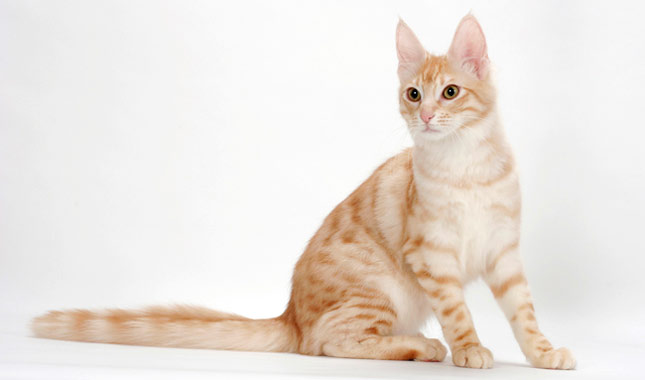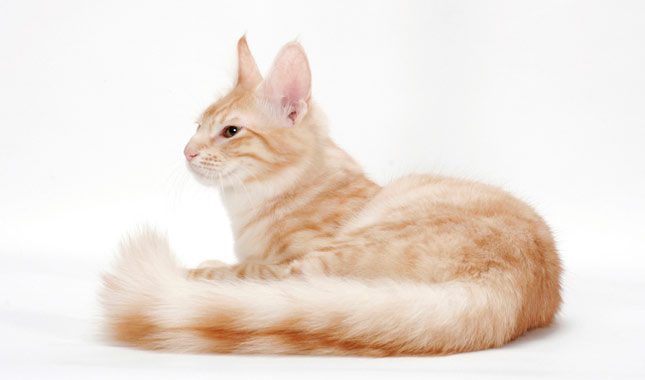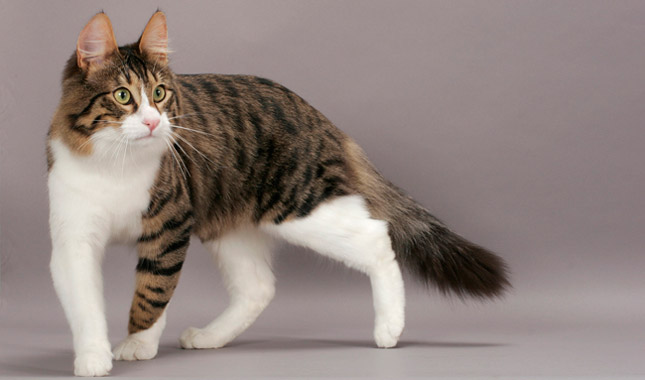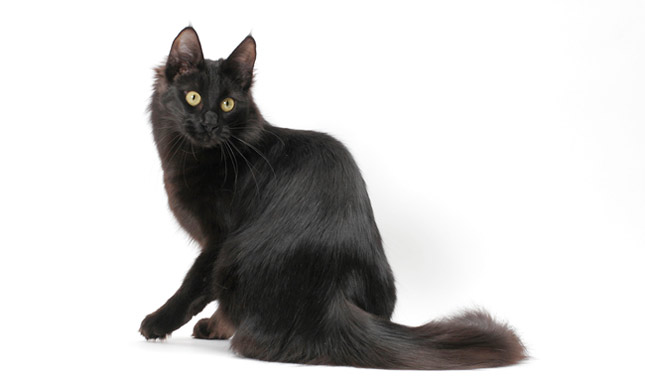Turkish Angora
Published on July 07, 2011
Breed Characteristics
Adaptability
Energy Level
Child Friendly
Social Needs
Shedding Level
Grooming
Health Issues
Stranger Friendly
Affectionate
Dog Friendly
Intelligence
The Angora is a natural breed, not manmade, and existed in Turkey at least as far back as the 15th century. Angoras are usually thought of as white cats with blue or green eyes, but they come in many colors and patterns, including tortoiseshell, tabby and calico. They are a small to medium-size cat.In his homeland, the Turkish Angora is considered a national treasure, and it’s easy to see why. Fine-boned and elegant, with a wedge-shaped head, a long silky coat and a plumed tail, this cat is often described as ballerina-like. Never think that he’s delicate, though. The Angora has not only the grace of a ballerina but also the strength.
Turkish Angoras weigh between five and nine pounds and live for 13 or more years. They may look beautiful and sophisticated, but underneath that elegant exterior they are tricksters with a wicked sense of humor. The outgoing Turkish Angora will greet guests at the door and play host with aplomb. He can get along with other pets, including dogs, after making sure they know he is the one in charge. In the same vein, he will be happy to supervise everything you do, preferably from on high. He is quite clever and is good at opening cabinet doors and turning on faucets (or teaching you to do it for him). This is an active, demanding, willful cat, but his beauty makes up for a lot.
The Turkish Angora is well suited to any home where he is loved, appreciated and given the care and attention he needs. Keep him indoors to protect him from cars, diseases spread by other cats and attacks from other animals.
Other Quick Facts
- For many years, all longhaired cats were referred to simply as “Angoras.”
- All Turkish Angoras registered by CFA must be able to trace their ancestry back to Turkey.
- Turkish Angoras are most commonly thought of as white, but they come in many colors and patterns, including black, blue, red, cream, tortoiseshell, and classic, mackerel and spotted tabbies of many colors.
- An Angora in full winter coat has a mane, britches on the hind legs, and a fully plumed tail.
- Some Turkish Angora breeders still import cats from Turkey. A breeder advertising “imported lines” usually means they are using foundation stock from Turkey.
The History of Turkish Angoras
It’s hard to imagine that this cat with the long, delicate, silky coat comes from the harsh mountainous regions of Turkey, but that coat protected the cat quite nicely against chill winters in Ankara, formerly known as Angora (also home to the Angora goat, which produces the fleece for mohair). The cats may be descendants of the Manul cat, domesticated by the Tatars.
The earliest written reference to the cats dates to 16th century France, so they were no doubt popular objects of trade. At the birth of cat shows in the late 19th century, Angoras were among the breeds exhibited. That was their downfall. Persian breeders began to use them in their breeding programs, and in England, at least, the Angoras lost their identity as a separate breed. Fortunately, they still existed in their homeland, where they were considered a national treasure. A breeding program was established at the Ankara Zoo to preserve them.
In the 1950s, American servicemen stationed in Turkey saw the cats and told people at home about them. The zoo was reluctant to part with any of its cats, but in 1962 it gave a pair to Colonel and Mrs. Walter Grant: an odd-eyed white male and an amber-eyed white female. They became the foundation of a breeding program in the United States. Two years later, Sergeant and Mrs. Ivan Leinbach brought a pair back to Arizona, followed by Mrs. Ray Porter, who imported a pregnant female whose kittens had been sired by one of the stud cats at the Ankara Zoo. More of the cats were imported in the 1970s.
The Cat Fanciers Associations began registering white Turkish Angoras in 1968 and recognized them for championship status in 1972. Colored Turkish Angoras were not recognized by CFA until 1978. Turkish Angoras are also recognized by The International Cat Association and other cat registries.
Turkish Angora Temperament and Personality
The Turkish Angora is a triple A cat: active, agile and assertive. He is in charge from day one and will take an interest in everything you do, offering his assistance at every step of the way. His energetic nature, sense of humor and quick wits can make him a great choice for families with children (just make sure they don’t pull his hair or tail) and a lively friend for anyone else, including seniors. He will rule dogs and other cats with an iron paw.
Don’t think that you can leave the Turkey to entertain himself. He likes interactive play and will be bored if you don’t give him what he thinks is an appropriate amount of attention. To exercise his body and his hunting instinct, provide him with toys he can chase and tall cat trees he can climb. He likes being up high.
Try not to give this cat opportunities to learn bad habits. Once he gets something into his head, it is difficult to change his mind.
Challenge his brain and keep him interested in life by teaching him tricks and providing him with puzzle toys that will reward him with kibble or treats when he learns how to manipulate them.
Always choose a kitten from a breeder who raises litters in the home and handles them from an early age. Meet at least one and ideally both of the parents to ensure that they have nice temperaments.
What You Need to Know About Turkish Angora Health
All cats have the potential to develop genetic health problems, just as all people have the potential to inherit a particular disease. Run, don’t walk, from any breeder who does not offer a health guarantee on kittens or who tells you that her kittens are isolated from the main part of the household for health reasons. Never buy a kitten from a breeder who does not provide a health guarantee.
Turkish Angoras are generally healthy, but white Turkish Angoras with blue eyes are prone to deafness. Odd-eyed white cats may lose hearing in only one ear. Fortunately, deaf cats can get around quite well, but the possibility is something to be aware of.
Some Turkish Angoras may develop a heart condition called hypertrophic cardiomyopathy, which is the most common form of heart disease in cats. It causes thickening (hypertrophy) of the heart muscle. An echocardiogram can confirm whether a cat has HCM. Avoid breeders who claim to have HCM-free lines. No one can guarantee that their cats will never develop HCM. Angoras that will be bred should be screened for HCM, and cats identified with HCM should be removed from breeding programs.
Remember that after you’ve taken a new kitten into your home, you have the power to protect him from one of the most common health problems: obesity. Keeping an Angora at an appropriate weight is one of the easiest ways to protect his overall health. Make the most of your preventive abilities to help ensure a healthier cat for life.
The Basics of Turkish Angora Grooming
The silky coat of the Turkish Angora does not shed much and is easy to groom with weekly combing. You may want to bathe him every couple of months, especially if he is white or light-colored. If he’s one of the water-loving Angoras, he won’t mind a bath at all.
The rest is basic care. Trim his nails every week or so, and brush his teeth with a vet-approved pet toothpaste for good overall health and fresh breath.
Choosing a Turkish Angora Breeder
You want your Turkish Angora to be happy and healthy so you can enjoy your time with him, so do your homework before you bring him home. For more information on the history, personality and looks of the Turkish Angora, or to find breeders, visit the websites of the Cat Fanciers Association, Cats Center Stage, the Fanciers Breeder Referral List, and The International Cat Association.
A reputable breeder will abide by a code of ethics that prohibits sales to pet stores and wholesalers and outlines the breeder’s responsibilities to their cats and to buyers. Choose a breeder who has performed the health certifications necessary to screen out genetic health problems to the extent that is possible, as well as one who raises kittens in the home. Kittens who are isolated can become fearful and skittish and may be difficult to socialize later in life.
Lots of reputable breeders have websites, so how can you tell who’s good and who’s not? Red flags include kittens always being available, multiple litters on the premises, having your choice of any kitten, and the ability to pay online with a credit card. Those things are convenient, but they are almost never associated with reputable breeders.
Whether you’re planning to get your feline friend from a breeder, a pet store, or another source, don’t forget that old adage “let the buyer beware”. Disreputable breeders and unhealthy catteries can be hard to distinguish from reliable operations. There’s no 100% guaranteed way to make sure you’ll never purchase a sick kitten, but researching the breed (so you know what to expect), checking out the facility (to identify unhealthy conditions or sick animals), and asking the right questions can reduce the chances of heading into a disastrous situation. And don’t forget to ask your veterinarian, who can often refer you to a reputable breeder, breed rescue organization, or other reliable source for healthy kittens. Put at least as much effort into researching your kitten as you would into choosing a new car or expensive appliance. It will save you money in the long run.
Be patient. Depending on what you are looking for, you may have to wait six months or more for the right kitten to be available. Many breeders won’t release kittens to new homes until they are between 12 and 16 weeks of age.
Before you buy a kitten, consider whether an adult Turkish Angora might be a better choice for your lifestyle. Kittens are loads of fun, but they’re also a lot of work and can be destructive until they reach a somewhat more sedate adulthood. With an adult, you know more about what you’re getting in terms of personality and health. If you are interested in acquiring an adult cat instead of a kitten, ask breeders about purchasing a retired show or breeding cat or if they know of an adult cat who needs a new home.
Adopting a Cat from Turkish Angora Rescue or a Shelter
The Turkish Angora is an unusual and uncommon breed. It is unlikely that you will find one in a shelter or through a rescue group, but it doesn’t hurt to look. Sometimes pedigreed cats end up at the shelter after losing their home to an owner’s death, divorce or change in economic situation. Check the listings on Petfinder , Adopt-a-Pet.com or the Fanciers Breeder Referral List, and ask breeders if they know of a Turkish Angora who is in need of a new home.
Wherever you acquire your Turkish Angora, make sure you have a good contract with the seller, shelter or rescue group that spells out responsibilities on both sides. In states with “pet lemon laws,” be sure you and the person you get the cat from both understand your rights and recourses.
Kitten or adult, take your Turkish Angora to your veterinarian soon after adoption. Your veterinarian will be able to spot problems, and will work with you to set up a preventive regimen that will help you avoid many health issues.









